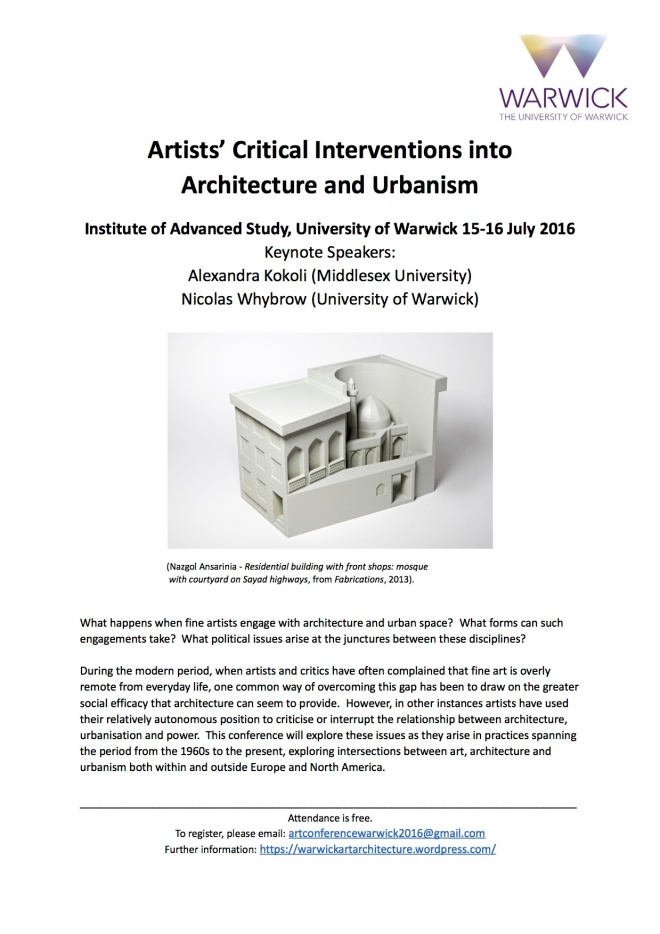It’s that time of year again when I realise that I have neglected this blog, take stock and reflect back on the (academic) year. As academics, we rarely stop to take a breath and to look back, as we’re often looking ahead, always working towards the next thing (I recently read about the 2:2:2 rule – always having two ideas, two in process and two publications under review, or something to that effect!) This is my pause, and reflection on the year…
I’ve presented papers at a number of conferences throughout the year, beginning in Rome, at the Historical Materialism Rome conference in September where I spoke about directors, actors and virtuosos in Paolo Virno and Walter Benjamin’s writings in relation to neoliberal social art practices. I ended the paper with a hypothesis that Rimini Protokoll’s performances confront the viewer-participant with real life contemporary working models thus pentrating life rather than simply reflecting it. As a theory-heavy paper, I was left wanting to do more work on the performances…
The opportunity to do more work on Rimini Protokoll presented itself when I spoke at the AAH 2016 Annual Conference at the University of Edinburgh in April. This time, answering the call for papers looking at social reproduction and art, I also returned to think about women and labour. I’ve found myself engaging more with Marxist-Feminist discourse after last year looking at texts navigating the history of the split between Marxism and Feminism. I presented continued work on Harrison, Hunt & Kelly’s Women and Work: A Document on the Division of Labour 1973-5, identifying the equality given to both the productive and the unproductive socially reproductive labour evident in the work.
After presenting the paper for the Labours of Love AAH panel, I was invited to collaborate on a roundtable discussion about social reproduction and art with two of the other speakers – Helena Reckitt and Jenny Richards. Having never co-authored a text for publication before, I approached the collaboration with a little trepidation. I had no idea how the conversation would take place, if one person would dominate, if there would be periods of silence, unanswered emails…My experience was, presumably, clouded by my experience of group work whilst studying at university. However, I was more than pleasantly surprised once we began to talk (via Skype) and write. The group writing session was organised via a Google Doc and we set a period of time to initially co-write the conversation. I can honestly say that having a set time for writing/having a conversation on the page, has been one of the most productive writing experiences of my academic career. We soon reached our 6000 words and then devoted pockets of time to editing. Each had an equal amount of words and all three approaches were addressed in the text. We’re currently in peer-review phase so watch this space…
In the meantime, my article on art fabrication, deskilling and late capitalism was published in Sculpture Journal, which looks at the mid-late C20th art fabricator Lippincott Inc. in relation to works made for/by Claes Oldenburg and Robert Morris in terms of internal changes within late capitalism – the deskilling of work – and asking whether this ideologically had an impact on artistic production. (Online here, for those interested and with institutional access or otherwise: http://goo.gl/yiOP1g)
Days before my annual leave was to begin, I presented another paper at Warwick University for the Artist’s Critical Interventions in Architecture and Urbanism Conference. This time, I returned to think about the public square in relation to new public art practices. In some ways, my year has come full circle, as I drew upon some of the philosophical ideas coming out of Virno’s A Grammar of the Multitude (2004) which I cited in my Rome paper at the beginning of the year. This time, Virno took me back to Arendt’s conception of the virtuoso and his links to the politician in Ancient Greece. This allowed for me to consider the role of the virtuoso and its alignment with politics in the social public art practices of Suzanne Lacy, Mosireen and Allora & Calzadilla. This paper is currently being worked into a journal article to be submitted in September.
Whilst presenting and writing journal articles, I’ve also been writing for Red Pepper (http://www.redpepper.org.uk/by/danielle-child/), contributed book and exhibition reviews (Review of Out of Time, Out of Place for Art & the Public Sphere journal here: http://www.intellectbooks.co.uk/journals/view-Article,id=21010/_ )
So there you have it, an academic year in the life of an ECR academic (now almost 5 years post-PhD). The year ahead will see me take some time out from teaching to write my forthcoming book (more later) and, hopefully, using this blog to log the process, amongst other things.




